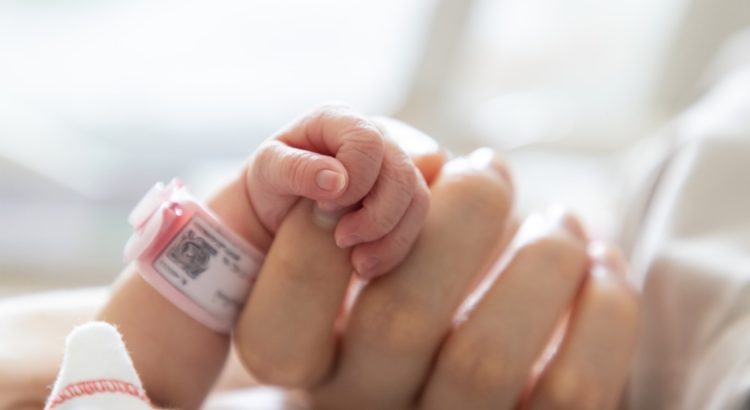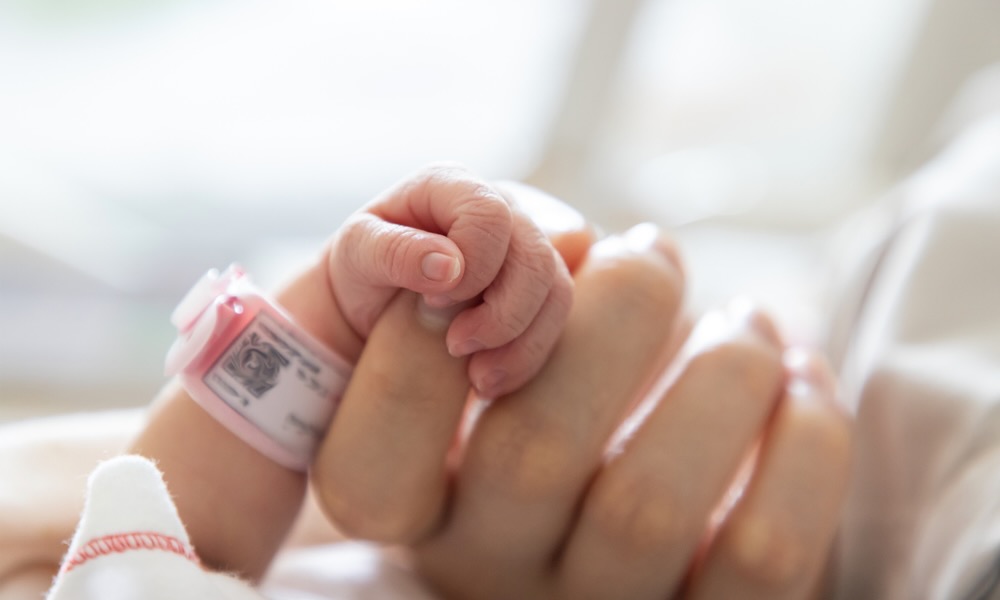
What has caused the spikes in neonatal deaths?
There is an investigation underway into two spikes in neonatal deaths in Scotland seen in September 2021 and March 2022. Public Health Scotland have now shared data on pregnancy outcomes after covid and after vaccination which provide a clue as to the cause.
Background
Let’s start with background rates and trends in Scottish neonatal deaths rates and stillbirth rates. Here is the data for 2000-2018. The green line is the neonatal death rate (within 28 days of birth) and the blue line is the stillbirth rate. Both have been declining in recent years but throughout this period the stillbirth rate has been around 2 per 1,000 higher than the neonatal death rate. The rates in 2018 were around 2.1 per 1,000 neonatal deaths and 3.3 per 1,000 stillbirths. By 2020 these figures were 2.1 and 4.2 respectively.
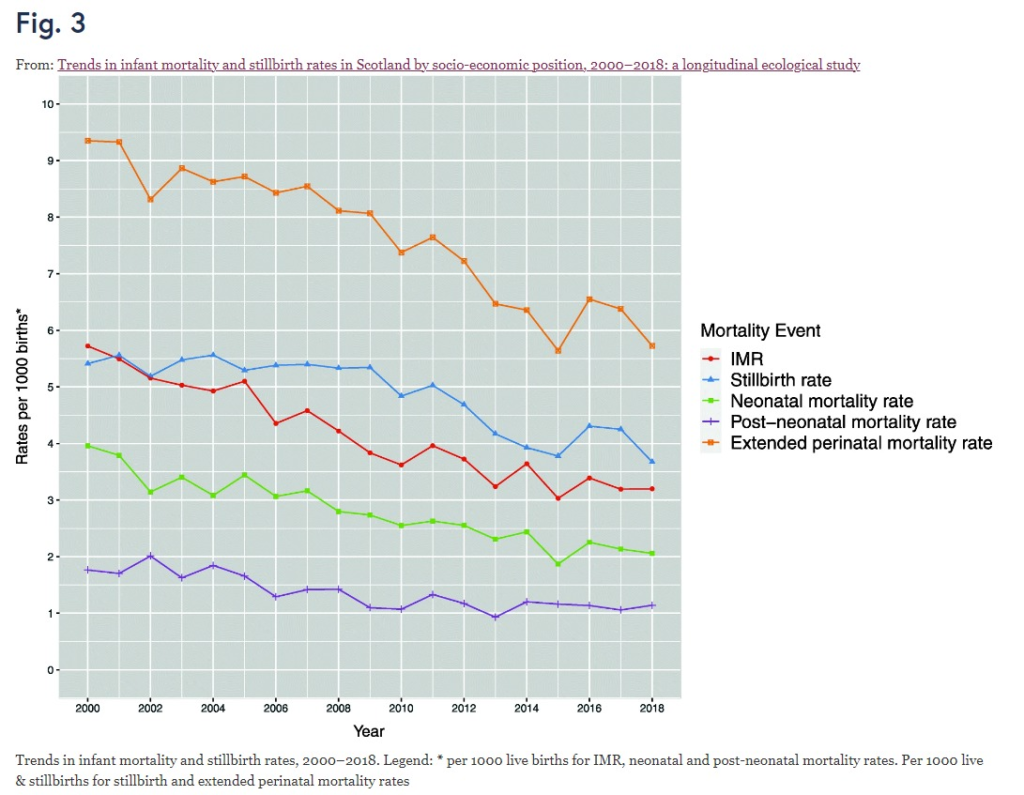
Covid risks
Covid has an impact on these rates. There have been a total of 12,778 births to women who at some point in pregnancy tested positive for covid. For the majority of these women covid had no impact on outcomes (see table 1). However, for the 1,982 women who delivered within 28 days of a positive test result the outcomes were significantly worse, particularly in terms of risk of stillbirth.
| Neonatal deaths per 1,000 | Stillbirths per 1,000 | |
| 2018 rates | 2.1 | 3.3 |
| 2020 rates | 2.1 | 4.2 |
| Covid at any point in pregnancy | 1.9 | 3.1 |
| Covid 28 days prior to delivery | 3.5 | 9.6 |
| Vaccination at any point in pregnancy | 1.7 | 2.7 |
| Vaccination 28 days prior to delivery | 3.4 | 2.7 |
Despite much higher prevalence of covid in March 2020, November 2020 – January 2021 and July 2021 and January 2022, the only concerning rise in total stillbirth numbers was present in July 2020 (see figure 2).

This does beg the question as to whether the data for those testing positive within 28 days is distorted in some way. Mothers who were admitted for the later stages of pregnancy, due to pregnancy complications, will have been repeatedly tested for covid in a hospital environment where virus was plentiful. Any over-testing of that sort would result in women testing positive being disproportionately likely to have stillbirths and neonatal deaths due to other pregnancy related complications. Such a bias would explain why, despite the stillbirth rate apparently being three times higher, there is no impact of covid waves on stillbirth rates overall. Likewise, the extra deaths have no impact on overall neonatal deaths and stillbirths for the whole cohort testing positive for covid, despite this being a small number. Overdiagnosis during pregnancy has been evident in the higher case rates in women of child bearing age seen in figure 3.
Because the word “vaccine” has been used to describe these novel products, doctors assume that the risk from covid in pregnant women will be reduced by injection. There is scant evidence to support that claim. The only government still publishing on case rates is Israel and their data clearly shows a higher and increasing case rate in the recently vaccinated population.
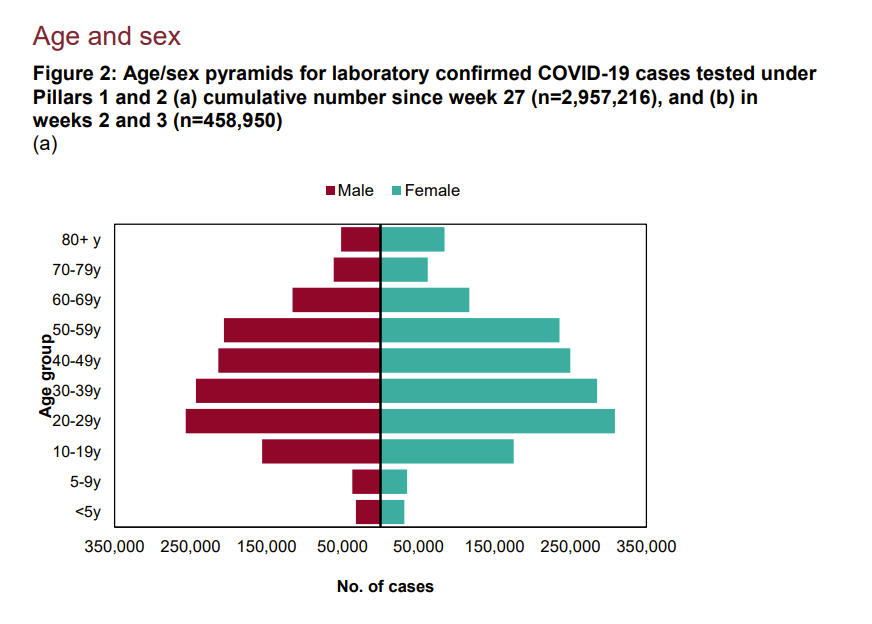
Vaccination risks
Vaccination also had an impact on these rates. There were 24,008 babies who were born after their mothers were injected during pregnancy. Of these 2949 were born within 28 days of the injection. For those women vaccinated at any point in pregnancy, the neonatal death and stillbirth rates were lower than normal range for these women. However, the neonatal death rate doubles for births within 28 days of the vaccination.
Why might the underlying rates be lower? There are marked differences in neonatal death and stillbirth rates depending on ethnicity and levels of deprivation. Groups who are more likely to be vaccinated have lower underlying rates. Figure 4 shows the rates by levels of deprivation. Neonatal mortality rates for less deprived groups were around 1.5 per 1,000 by 2018 and stillbirth rates were less than 3 per 1,000. Figure 4 includes an “X” showing the rates for the Scottish population within 28 days of vaccination. While the stillbirth rate suggests this population as a whole are similar to the less deprived groups, the neonatal death rate is of a similar order to the most deprived groups over ten years ago.
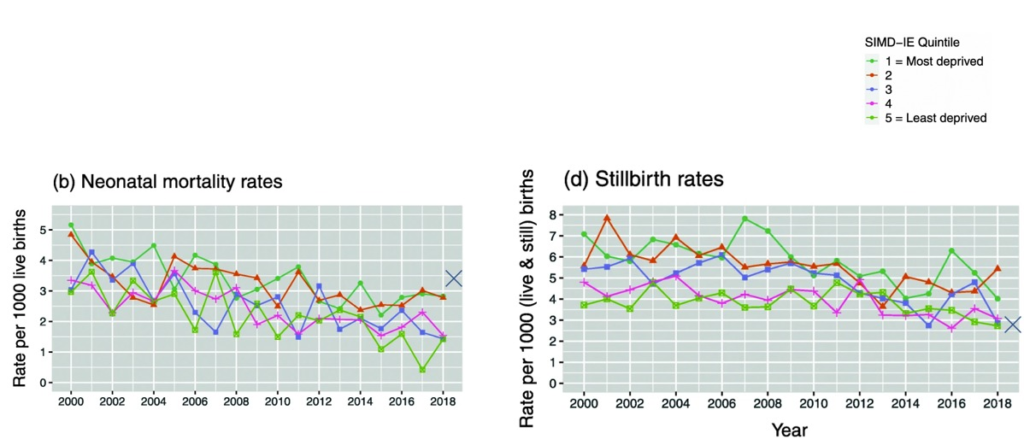
Risk Exposure
Although the apparent risk from covid is higher the chance of covid exposure is low. The COPS pregnancy cohort includes 189,912 pregnancies that have been tracked. Of those fewer than one in ten (18,564) had a covid infection between 1st March 2020 to 30th April 2022. However, the chance of vaccine exposure is very high. On average a pregnant woman would receive more than one injection in pregnancy. A total of 45,098 covid vaccinations were given during 32,314 pregnancies. The covid risk therefore only occurs to one in ten pregnant women whereas the risk from vaccination is guaranteed for those women who are vaccinated during pregnancy and is increased further with subsequent doses.
Overall Impact
The total number of neonatal deaths within 28 days of a covid positive test was only 7 (3 more than expected levels) and the total number within 28 days of vaccination was only 10 (4 more than expected levels). A proportion of both of these will have been coincidental Therefore, this window of time is insufficient to explain the rise in neonatal deaths. In September 2021, there were 21 deaths, where 9 would have been expected at normal rates, and in March 2022 there were 18 deaths, where 8 would have been expected at normal rates. Therefore, there has been a total of 22 deaths above expected levels which cannot be explained by the 7 extra deaths over the whole period that occurred within 28 days of a covid test or vaccination.
Therefore, it is worth looking beyond that 28 day period.
Neonatal deaths trajectory
The spike in neonatal deaths occurs 1 month after the peak for second doses given in pregnancy and 3 months after the booster doses. Figure 5 shows the doses given to pregnant Scottish women scaled to match the time axis for neonatal deaths.
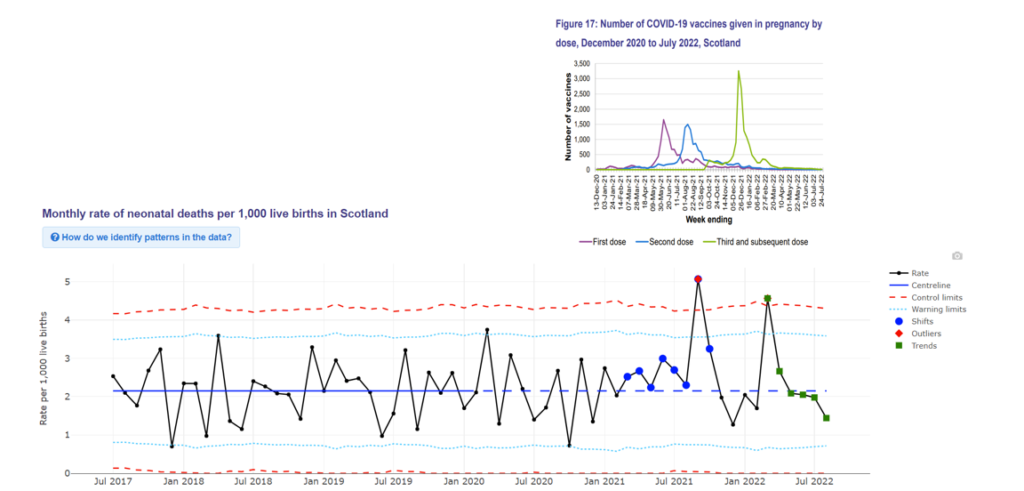
The stillbirth rate gives an indication that the vaccinated population has a similar risk to the less deprived cohorts. If we carry this forward, then a neonatal death rate of 1.5 would be expected. For women vaccinated at any point in pregnancy the neonatal death rate was 1.7. This works out at 4 extra deaths which would be accounted for by the four deaths within 28 days of vaccination. Therefore, vaccination during pregnancy does not appear to be the cause of the excess.
Likewise, the overall covid rates were below expected levels so a consequence of covid infection earlier in pregnancy could not account for these extra deaths.
Investigation
It is to be noted that Public Health Scotland has been far more transparent with this data than any other country. The investigation must of course cover numerous possible contributory factors. However, given the timing of the peaks in neonatal deaths it would be a great reassurance to see the data on how many of those mothers had been vaccinated prior to or during pregnancy compared to the underlying rates for pregnant women at the time. It is a shame that such a simple additional piece of information has been withheld.
Conclusion
The risk from covid in pregnancy seems to have been exaggerated on two counts. Firstly, most pregnant women will not catch covid during their pregnancy so the overall risk needs to account for the low underlying risk of infection. Secondly, overtesting of women with complications of pregnancy appears to have distorted the rates of neonatal deaths and stillbirths in those testing positive within 28 days of delivery.
The risk from vaccination is guaranteed for any women vaccinated in pregnancy. There does appear to be a small increased risk in neonatal deaths for those vaccinated within 28 days of delivery but there is no impact on stillbirth rates.
The 22 extra deaths from spikes seen in September 2021 and March 2022 remain unaccounted for.
